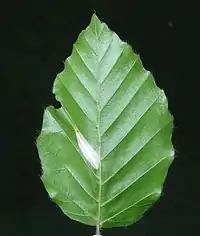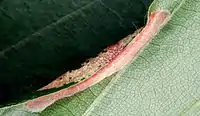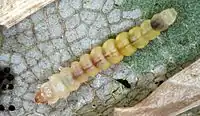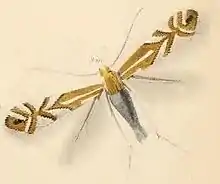Phyllonorycter maestingella
Phyllonorycter maestingella is a moth of the family Gracillariidae. It is found in Europe, Russia and British Columbia, Canada.[1]

tubular mine between veins

feeding signs of larva

larva
| Phyllonorycter maestingella | |
|---|---|
 | |
 | |
| Scientific classification | |
| Domain: | Eukaryota |
| Kingdom: | Animalia |
| Phylum: | Arthropoda |
| Class: | Insecta |
| Order: | Lepidoptera |
| Family: | Gracillariidae |
| Genus: | Phyllonorycter |
| Species: | P. maestingella |
| Binomial name | |
| Phyllonorycter maestingella (Müller, 1764) | |
| Synonyms | |
| |
The imago (moth) is bivoltine (depending on geographic location) flying in May and June and again in August. The wingspan is 7–9 mm and the wings have an intricate pattern of orange-brown, black and white.[2]
The pale greenish-yellow larva feeds on beech (Fagus species) making a long blotch mine on the underside of the leaf, usually between two veins from midrib almost to leaf edge. If the mine is at the margin of the leaf it can cause it to fold downwards.[3] The cocoon is to one side of the frass which is piled neatly along the middle of the mine.[4]
References
- Shared but overlooked: 30 species of Holarctic Microlepidoptera revealed by DNA barcodes and morphology
- Kimber, Ian. "Phyllonorycter maestingella". UKmoths. Retrieved 1 August 2016.
- Emmet, A M (1988). A Field Guide To The Smaller British Lepidoptera (Second ed.). London: The British Entomological and Natural History Society. p. 65.
- Edmunds, Rob. "Beech (Fagus)". British leafminers. Retrieved 1 August 2016.
This article is issued from Wikipedia. The text is licensed under Creative Commons - Attribution - Sharealike. Additional terms may apply for the media files.